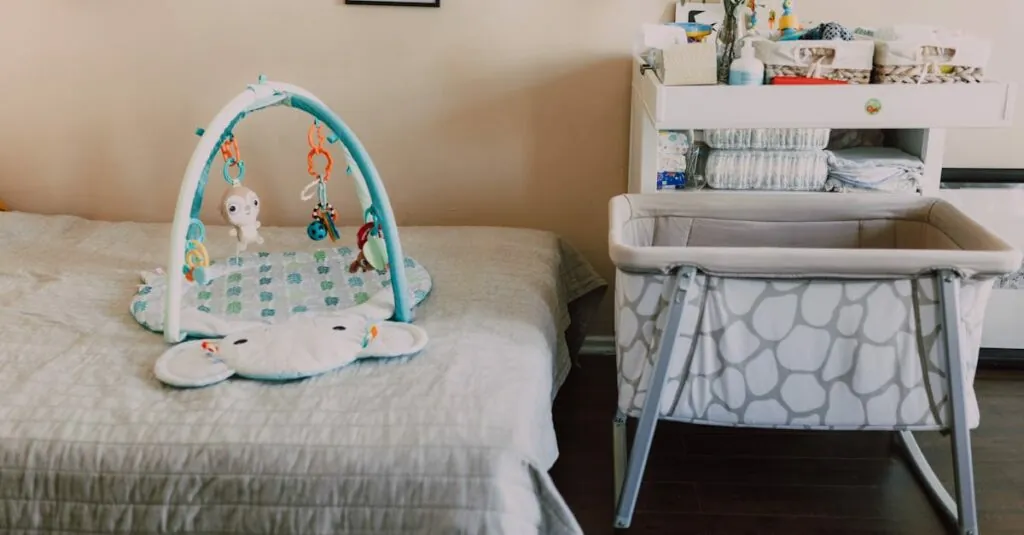When it comes to baby gear, the bassinet often steals the show as the cozy throne for tiny royalty. But how long do babies actually stay in this cushy kingdom? Spoiler alert: it’s not forever! As adorable as they are, babies grow faster than parents can keep up with, and soon enough, they’ll be ready to transition to bigger digs.
Table of Contents
ToggleUnderstanding Bassinets
Bassinets serve as safe sleep spaces for newborns and young infants. Designed for comfort, they typically feature soft bedding and snug sides. Standard bassinets accommodate babies until they reach around 15 to 20 pounds, which often occurs by six months of age.
Parents often find that babies transition from bassinets to cribs sooner than expected. Growth spurts, mobility, and developmental milestones can prompt this change. Infants begin to roll over, sit up, or push up during sleep, making bassinets less suitable as they approach these milestones.
Features of bassinets vary, but safety remains a top priority. Many bassinets come with a portable design, allowing easy movement around the home. Some models include adjustable heights or rocking mechanisms, adding additional convenience for caregivers.
Bassinets can often fit into smaller spaces, making them ideal for compact living environments. Parents appreciate bassinets for their ability to keep infants close during the night, facilitating easier feeding and soothing.
Transitioning to a crib is a natural progression as babies outgrow their bassinets. The American Academy of Pediatrics recommends starting this transition when the baby shows signs of outgrowing the bassinet or reaching the weight limit. Recognizing these signs ensures a smooth shift to a safer sleep environment for the growing child.
Factors Influencing Duration
Several elements dictate how long babies stay in a bassinet. Understanding these factors helps parents prepare for a smooth transition.
Baby’s Age
A baby’s age plays a crucial role in determining bassinet duration. Newborns often remain in bassinets for the first three to six months. As they approach six months, developmental milestones, such as rolling over, will indicate a time to transition. Many infants show signs of readiness around this age, signaling it’s time for a bigger sleeping space. Regular monitoring can help parents identify the right moment for this change.
Baby’s Weight and Size
A baby’s weight and size also significantly influence the time spent in a bassinet. Most bassinets accommodate infants weighing up to 15 to 20 pounds. Once the baby reaches this threshold, safety concerns arise, prompting a switch to a crib. Additionally, physical growth can lead to increased restlessness. Parents should keep track of their child’s growth patterns, ensuring safety remains a priority during the transitioning phase.
Safe Sleep Guidelines
Safe sleep practices ensure infants rest securely and comfortably. Parents must remain informed about guidelines to promote a healthy sleep environment.
SIDS Awareness
SIDS, or sudden infant death syndrome, poses a risk for infants, especially during the first year of life. Awareness of risk factors can significantly reduce instances. Placing babies on their backs for sleep lowers the risk. Keeping the sleep area free of soft bedding, pillows, and toys is essential. Additionally, a room temperature that prevents overheating helps maintain a safe environment. Parents should avoid allowing infants to sleep on sofas or armchairs, which increases SIDS risk. Following these precautions can create a safer sleep setting.
Recommended Sleep Positions
Sleep position plays a crucial role in infant safety. Babies must always be placed on their backs for sleep. While some infants may prefer side sleeping, this position is not safe for unsupervised rest. Tummy time during awake hours helps develop muscles but should never occur during sleep. Transitioning infants to a crib upon showing signs of outgrowing a bassinet requires attention. Frequent monitoring of sleep positions is vital to promote safety. These practices contribute to healthier sleep habits for growing babies.
Transitioning from Bassinet to Crib
Transitioning from a bassinet to a crib marks an important milestone in a baby’s growth. Recognizing when to make this move ensures comfort and safety for the infant.
Signs Your Baby is Ready
Parents can look for various signs indicating readiness for the crib. Babies often show restlessness in their bassinet, suggesting they need more space to sleep comfortably. Weight is another key factor; exceeding 15 to 20 pounds typically signals a need for transition. Developmental milestones, such as rolling over or sitting up, also indicate it’s time for a crib. As babies approach six months, they frequently exhibit changes in their sleep patterns or comfort. Monitoring these signs helps facilitate a timely and safe transition.
Tips for a Smooth Transition
Implementing strategies can ease the transition from bassinet to crib. Gradually introducing the crib during naps familiarizes the baby with the new environment. Keeping the nursery soothing and familiar with favorite blankets or toys enhances comfort levels. Establishing a consistent bedtime routine reassures the baby, promoting relaxation. Parents should ensure the crib adheres to safety standards, including a firm mattress and absence of soft bedding. Patience is crucial; some babies may take time to adjust. Using gentle encouragement during this process significantly benefits the infant’s overall sleep experience.
Bassinets provide a cozy and safe sleeping environment for newborns and young infants. As babies grow and reach developmental milestones, parents should be prepared for the transition to a crib. This shift is essential for ensuring safety and comfort as babies exceed weight limits or show signs of readiness for a larger sleeping space.
By staying attentive to their child’s growth patterns and adhering to safe sleep guidelines, parents can promote healthy sleep habits. Ultimately, understanding the appropriate time to move from a bassinet to a crib helps support a baby’s development while ensuring peace of mind for caregivers.





